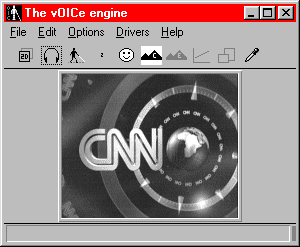 |
When using The vOICe for Windows in combination with a television card for your PC, it allows you to hear live television images as they are broadcast, or VCR recordings of the video in earlier television broadcasts or movies. Technical details on using a TV card are given on the Frequently Asked Questions page.
In the following, an example is given of one of the historical highlights of television, namely the Apollo missions to the moon. The lack of an atmosphere on the moon not only makes it impossible to breath there, but it also causes a total silence, except for the radio contact among the astronauts and planet Earth. Even sonar would be totally useless for hearing the environment on the moon. However, it is possible to see on the moon, and television recordings were made of the astronauts walking on the surface of the moon. You are about to hear and experience a fragment of one of these famous moonwalks in the example below. The vOICe technology provides access to any visual information, and lets you hear any images that can be shown on television.
Click the moonwalk link to load a MP3 sound sample containing a sequence of six soundscapes showing an astronaut walking towards the camera and then leaving the view on the right. File size is here only about 100K for six seconds of stereo sound.
Make sure that your media player runs in autorepeat mode such that you can listen to each soundscape a number of times. With Microsoft Windows Media Player 9 and 10 you can toggle the repeat mode via Control T or via the menu Play | Repeat. With the older Microsoft Windows Media Player 6.4 you can go to the menu View | Options, select the Playback tab and then select "Repeat forever".
Note for confused sighted readers trying to match the soundscapes to the corresponding animated .gif image as shown below: the MP3 sound sample here starts independent of the animated .gif, so the animation will not run synchronized to the soundscapes.
 |
The whole scene has the greyish lunar surface soil in the lower part of the view, and the black (hence silent) "sky" in the upper part. The shadows cast on the lunar surface by the lunar lander can be heard in the lower left of the scene (low-pitched on your left). Initially, the two astronauts are standing in the middle of the scene near the American flag that has been planted a moment ago. The astronaut on the left keeps holding the flag, which is just to the right as seen from our viewpoint. The second astronaut is standing to the right of the flag, and is then walking towards the viewer until he disappears from the view on your right side in the last soundscape. You can hear him become "bigger", which is the visual consequence of perspective as he approaches, and if you concentrate you can clearly hear his two legs when he is nearby, sounding as a low-pitched split in the approaching sound object, causing a very brief rhythm. The first astronaut and the flag remain approximately in the same position in the scene, and the camera does not move. Initially, you hear three objects rising above the horizon and near the middle of the scene: the astronaut holding the flag, the flag itself in the middle and the astronaut that is walking towards the camera on the right.
The soundscapes were created using The vOICe for Windows with 3D enhancement turned on, and afterwards the saved .wav files were converted into MP3 format to reduce the file size for downloading. Please keep in mind that learning to understand arbitrary television soundscapes will be a formidable training task, and it is not known how skilled blind people can get at soundscape interpretation.
Using a TV card for the PC, you can similarly hear the soundscapes of live visual reports from CNN or from any other television station!

However, many people may tell you that you will not be able to learn to make much sense of the strange cacophony of extremely complicated television image sounds. Perhaps they are right! Can the sceptics be proven wrong? So far no one knows the answer, but the technology to explore the power of seeing with sound is now available to you!
For further information, see also the Closed Captioning page.
Other MP3 sound samples can be found on the Blindsight of a Parked Car page, the Visual Orientation for the Blind page, the Hearing a Printed Graph page, the Planet Saturn page, the Access Symbol page and The vOICe of America page.
Wondering what Shirl Jennings would make of all this?
Wait for the sequel to Oliver Sacks - an anthropologist on Mars - to see or not see - at first sight - the movie.